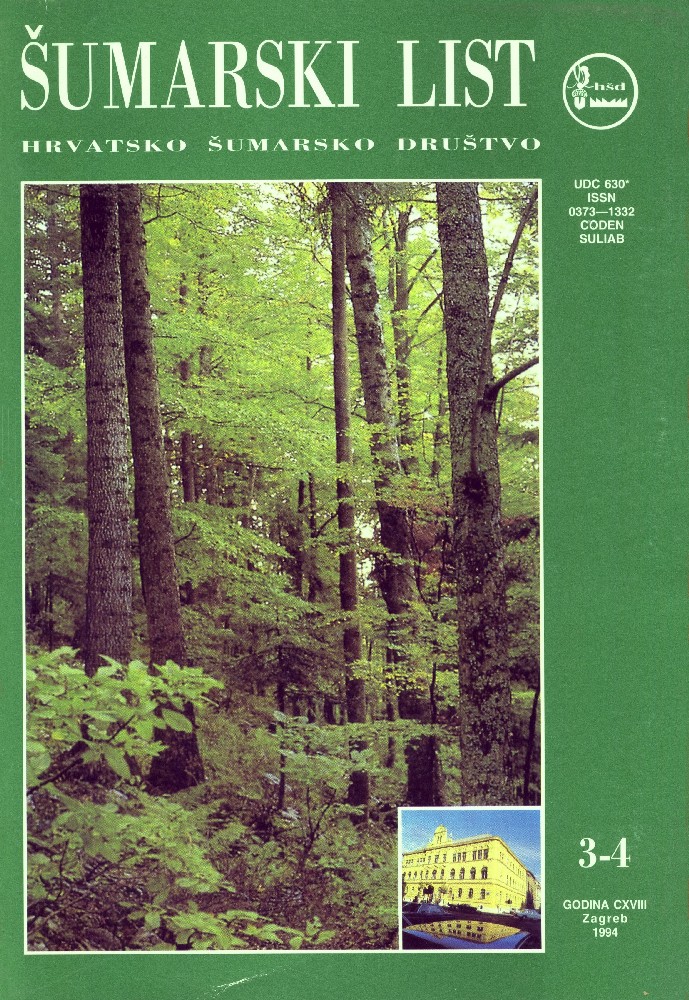
broj: 3-4/1994
pdf (14,6 MB) |
|
||||||||||||||
| IZVORNI ZNANSTVENI ČLANCI | ||
| Matić, S. | UDK 630* 232.319+322.9.001/2 | |
| Number of Plants and the Amount of Seed in Relationship to the Results of Regeneration and Afforestation pdf HR EN | 71 | |
| Trinajstić, L. | UDK 630*. *187.001 (497.13) | |
| Mesophilous Hornbeam-Forests (Ass. Anemone-Carpinetum betuli Trinajstić 1964) in Istria (Croatia) pdf HR EN | 81 | |
| Durbešić, P., Vujčić-Karlo, S., Bukvić, I. | UDK 630* 591.9/595.7.001 (497.13) | |
| Faunustic and Zoogeographie Research of Coleoptera-Insecta in some Forest Communities on Mountain Medvednica pdf HR EN | 85 | |
| Raguž, D., Grubešić, M., Tomljanović, J. i Markota, I. | UDK 630* 639.1 (497.13) Ovis ammon musimon Pallas. | |
| Comparison of Trophy Value of some Mouflon Population (Ovis ammon musimon Pallas.) in Croatia pdf HR EN | 91 | |
| Summary: Mouflon (Ovis ammon musimon Pallas.) represents an important species in the wildlife management of Croatia. The still insufficiently utilized natural potentials of the Mediterranean and sub-Mediterranean belt provide favourable conditions for intensification of wildlife management. Positive experience so far in breeding mouflons at some localities give it a top priority for future management. An investigation of the trophy structure of mouflons at hunting districts »Vranjak« Ploče and »Žrnovnica« Senj, and their comparison, confirm the justification for further breeding and propagation of this species. The hunting district »Vranjak« is located in the Mediterranean belt and »Žrnovnica« in the sub-Mediterranean belt. By data processing and analysis of 49 acquired trophies from the »Vranjak« hunting district and 27 from the »Žrnovnica« hunting district it can be concluded that there are no significant differences between these two populations. Research shows that the differences in climate and vegetational elements did not cause a change in the trophy structure of the populations. Hereditary traits of the populations are identical because they both originate from the Brioni Islands. Minor diferences occurring in the trophy structure are a reflection of management interventions and aims. Both population display an exceptionally good trend of horn development, so that after only three years nearly all the mouflons qualify for one of the medals. The above mentioned hunting districts, together with some others, are a guarantee for success in wildlife management of mouflons at suitable habitats on the Adriatic islands, along the coast and in wider coastal regions in the Mediterranean and sub-Mediterranean belts of Croatia. Key words: mouflon; hunting district; habitat; trophy; trophy assessment; mouflon; hunting district; habitat; trophy; trophy assessment | ||
| PREGLEDNI ČLANCI | ||
| Dimitrov, T. | UDK 630* 431. | |
| Biological Parameters Suitable for Improving the Forest Fire Danger Index pdf HR EN | 105 | |


